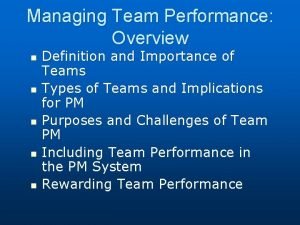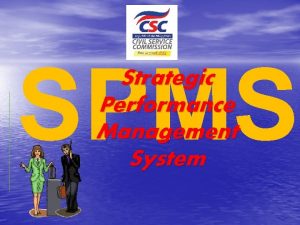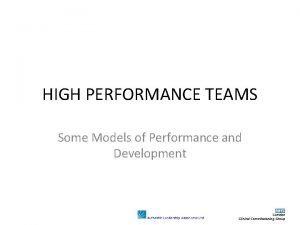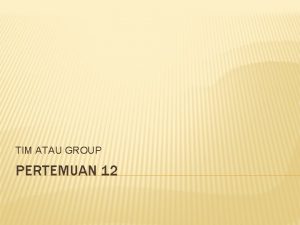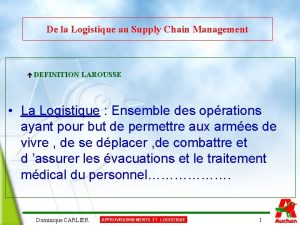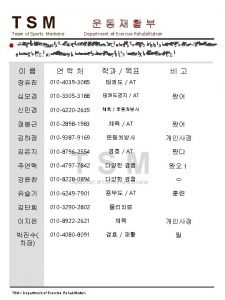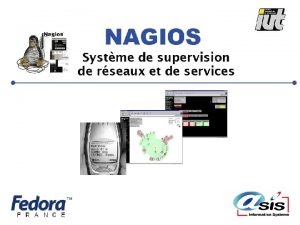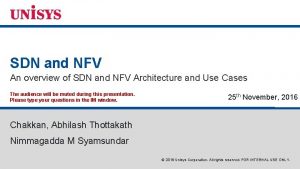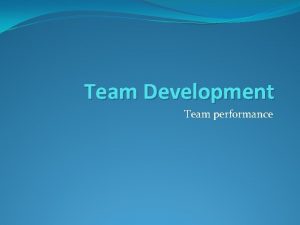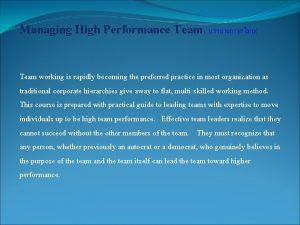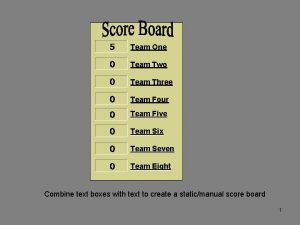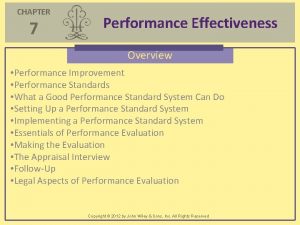Managing Team Performance Overview n n n Definition

































- Slides: 33

Managing Team Performance: Overview n n n Definition and Importance of Teams Types of Teams and Implications for PM Purposes and Challenges of Team PM Including Team Performance in the PM System Rewarding Team Performance

Definition of Team Two or more people • Interact Dynamically n Independently n • Share common and valued n Goal, Objective or Mission

Importance of Teams Increased pressure, including global competition n Flexibility in flatter organizations n Complexity of products and services n Rapidly changing business environments n

Performance Management & Teams n PM systems should target: • Individual performance • Individual’s contribution to team performance • Performance of entire team

General principles of PM relating to teams 1. Design and implement best system possible 2. Consider dangers of poorly implemented system

Managing for Improved Team Performance n n n Don’t limit team processes with other task or organizational requirements Provide good team design and organizational support Give feedback only on processes that the team members can control

Types of Teams n Classified by • Complexity of task • Membership configuration

Complexity of Task ranges from: n Routine • Well defined • Few deviations in how work is done • Outcomes easily assessed n - to Non-routine • Not defined well • No clear specifications on how to do the work • Outcomes are long term and difficult to assess

Membership Configuration includes n n Length of time team expects to work together Stability of team membership Static Dynamic

Types of Teams Based on Membership Configuration and Task Complexity Dynamic ° Network Teams ° Project Teams Membership Configuration Static ° Work and Service Teams Routine Non-Routine Task Complexity

Types of Teams n n n Work or Service Teams Project Teams Network Teams

Work or Service Teams n n n Intact Routine tasks Share similar skill sets

Project Teams n n n Assembled for specific purpose Tasks outside core product or service Members from different functional areas

Network Teams n Membership not constrained by • Time or space • Organizational boundaries n Teams may include • • n Temporary or full-time workers Customers Vendors Consultants Work is extremely nonroutine

Examples of PM Approaches by Type of Team n Type of Team • Work & Service Team • Project Team • Network Team n Type of PM Approach • Peer ratings • Ongoing measurements • Development of competencies

Purposes of Team PM n n Traditional goals of any PM System Specific to Team performance: • Make all team members accountable • Motivate all team members to have a stake in team performance

Challenges of Team PM n n n How do we assess relative individual contribution? How do we balance individual and team performance? How do we identify individual and team measures of performance?

6 Basic Principles for Designing a PM System That Includes Team Performance 1. 2. 3. 4. 5. 6. Make sure your team is really a team. Make the investment to measure. Define measurement goals clearly. Use a multi-method approach to measurement. Focus on process as well as outcomes. Measure long-term changes.

Performance Management Process (Overview/Review) Prerequisite s Performance Planning Performance Execution Performance Renewal and Recontracting Performance Review Performance Assessment

Prerequisites n Knowledge of mission • Organization • Team n Knowledge of job to be performed by the team, including KSAs

Prerequisites KSAs needed for most teams: • Task • Contextual Communication n Decision-making n Collaboration n Team leadership n Self-control n

Performance Planning n n n Results expected of the team Behaviors expected of team members Developmental objectives to be achieved by team and its members

Performance Execution Team responsibilities 1. 2. Commit to goal achievement Seek feedback from • • 3. 4. Each other Supervisor Communicate openly & regularly Conduct regular & realistic peer-appraisals

Performance Execution Supervisor responsibilities 1. Observe and document • Team performance • Relative contribution of team members 2. 3. Update team on any changes in goals of the organization Provide resources & reinforcement

Performance Assessment Types of Assessments n n Self-appraisals Peer evaluations Supervisor evaluation Outsider appraisals (if appropriate)

Performance Assessment Kinds of Performance to be Assessed n n n Individual task performance Individual contextual performance Team performance

Dimensions of Team Performance to Assess: n n Effectiveness Efficiency Learning and growth Team member satisfaction

Performance Review n Two meetings with supervisor or review board • Team meeting • Individual meeting n Emphasis on past, present and future

Team Meeting n Discuss overall team • Performance • Results n Information comes from: • Team members • Other teams/outsiders • Supervisor’s evaluation

Individual Meeting n n Discuss how individual behavior contributed to team performance Information comes from: • Self-appraisal • Peer ratings • Supervisor’s evaluation

Performance Renewal and Re. Contracting n n Make adjustments to performance plan Include plan for individual performance as it affects team functioning

Making Team-based Rewards Effective n n All employees should be eligible Rewards should be • Visible • Contingent • Reversible n n Avoid factors which cause reward systems to fail Consider variable pay systems (in addition to individual bonuses)

Quick Review n n n Definition and Importance of Teams Types of Teams and Implications for PM Purposes and Challenges of Team PM Including Team Performance in the PM System Rewarding Team Performance
 Team performance definition
Team performance definition Managing employee performance and reward
Managing employee performance and reward Going native project management
Going native project management Team spirit becomes team infatuation
Team spirit becomes team infatuation The white team cheers for the blue team, just like
The white team cheers for the blue team, just like Ipcr comments and recommendations sample
Ipcr comments and recommendations sample Team performance models
Team performance models Performance levels
Performance levels Behaviorally anchored rating scale
Behaviorally anchored rating scale Jcids manual 2018
Jcids manual 2018 What is product line depth
What is product line depth Group vs team definition
Group vs team definition Self management team definition
Self management team definition Meeting with team
Meeting with team Supply chain definition
Supply chain definition Sports medicine team definition
Sports medicine team definition One team one fight meaning
One team one fight meaning Team ministry definition
Team ministry definition Www description
Www description Maximo work order priority
Maximo work order priority Universal modelling language
Universal modelling language Uml
Uml Vertical overview
Vertical overview Figure 12-1 provides an overview of the lymphatic vessels
Figure 12-1 provides an overview of the lymphatic vessels Major veins of the body
Major veins of the body Texas public school finance overview
Texas public school finance overview Walmart company profile
Walmart company profile Stylistic overview
Stylistic overview Sa sd
Sa sd Spring framework overview
Spring framework overview Nagios tactical overview
Nagios tactical overview Market overview managed file transfer solutions
Market overview managed file transfer solutions Sdn nfv overview
Sdn nfv overview Sbic program
Sbic program
